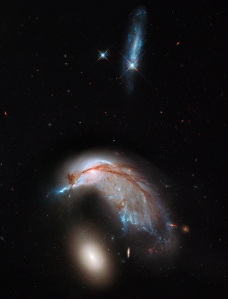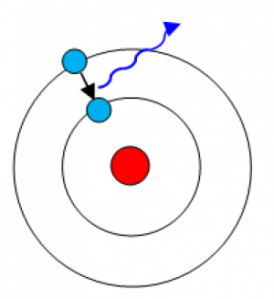Why are galaxies red? This is due to one element and only one – Hydrogen.
Hydrogen is nature’s smallest element and is, perhaps, the purest representation of what an atom actually is. The name Hydrogen actually comes from Greek words ‘hydro’ and ‘gen’ – which when put together mean “water-generator”.

Hydrogen was extensively studied by scientists such as Niels Bohr. Bohr’s simple atomic model had an electron orbiting a proton, just like in the diagram shown above. This is analogous to the Earth orbiting around the Sun. However the Bohr model is highly simplistic as quantum mechanics tells us that we never quite know exactly where the electron is.
Hydrogen also has very specific energy “shelves” where electrons are allowed to be. Despite the short comings of Bohr’s model the energy levels of these shelves can be calculated very accurately from the model.
So, in order to move an electron from one shelf to the next we need a very specific amount of energy. This is due to the discretization of angular momentum which meant an electron in the Bohr model could only exist at certain distances from the proton. If you give the atom more energy the electron will jump up to a higher shelf – at this point it’s in an excited state.
- Electron jumping down to a lower energy shelf [Image courtesy of http://phys.org]
If you let it sit there it will re-emit energy in the form of light and the electron will jump back down to a lower shelf. Now, if an electron jumps from the 3rd shelf to the 2nd shelf the electron emits visible light. This emission is so powerful that it can be seen throughout many galaxies:

It’s THAT emission that causes the glowing red lines in the galaxy shown above. In the case of the galaxy shown above (where in a previous blog post we looked at where its unusual shape came from) the clear red lines are where the galaxy is forming stars. This red glow from Hydrogen shows us very clearly where stars are being formed in the night sky.
So there you have it. These red lines splashed across the night sky are a visible sign that new stars are born and shows how hydrogen can make a galaxy glow a deep red.
